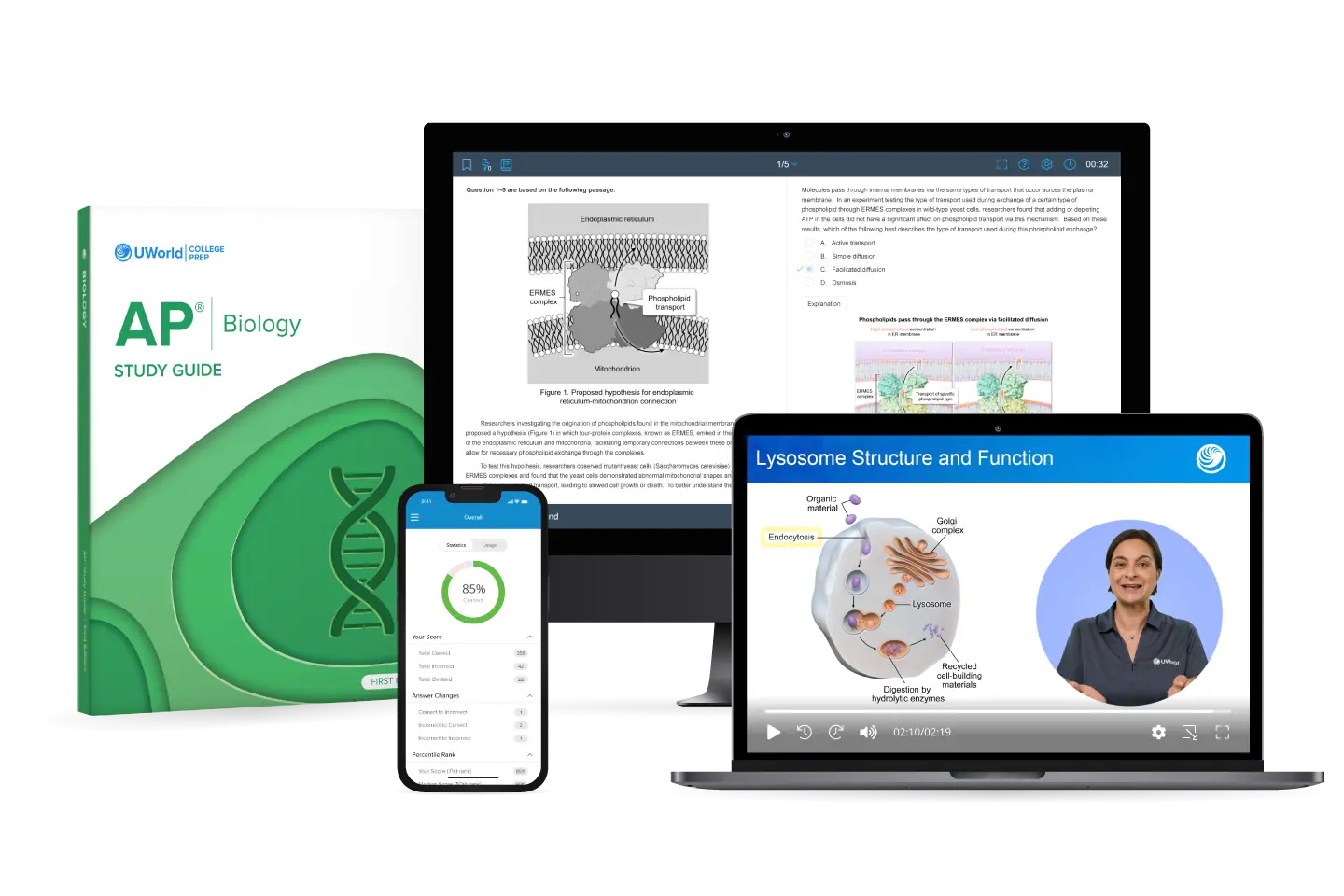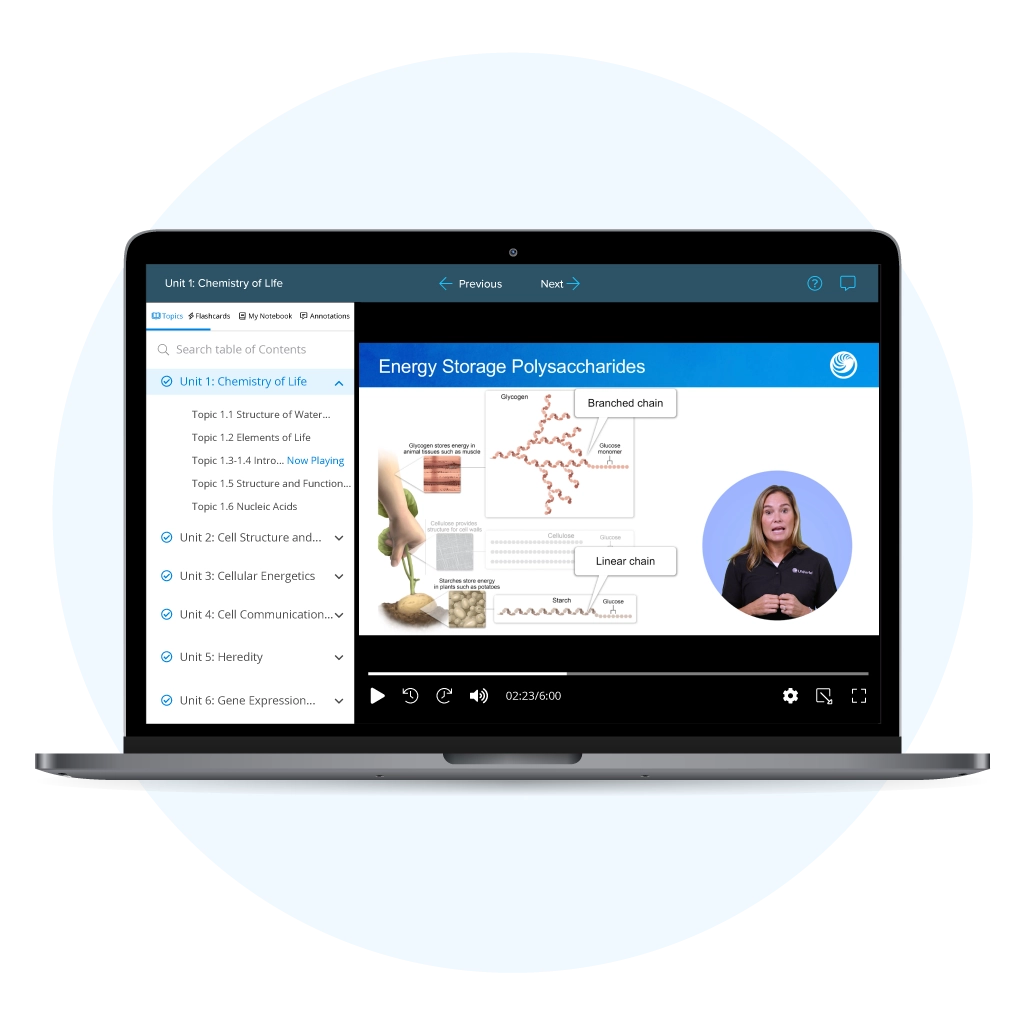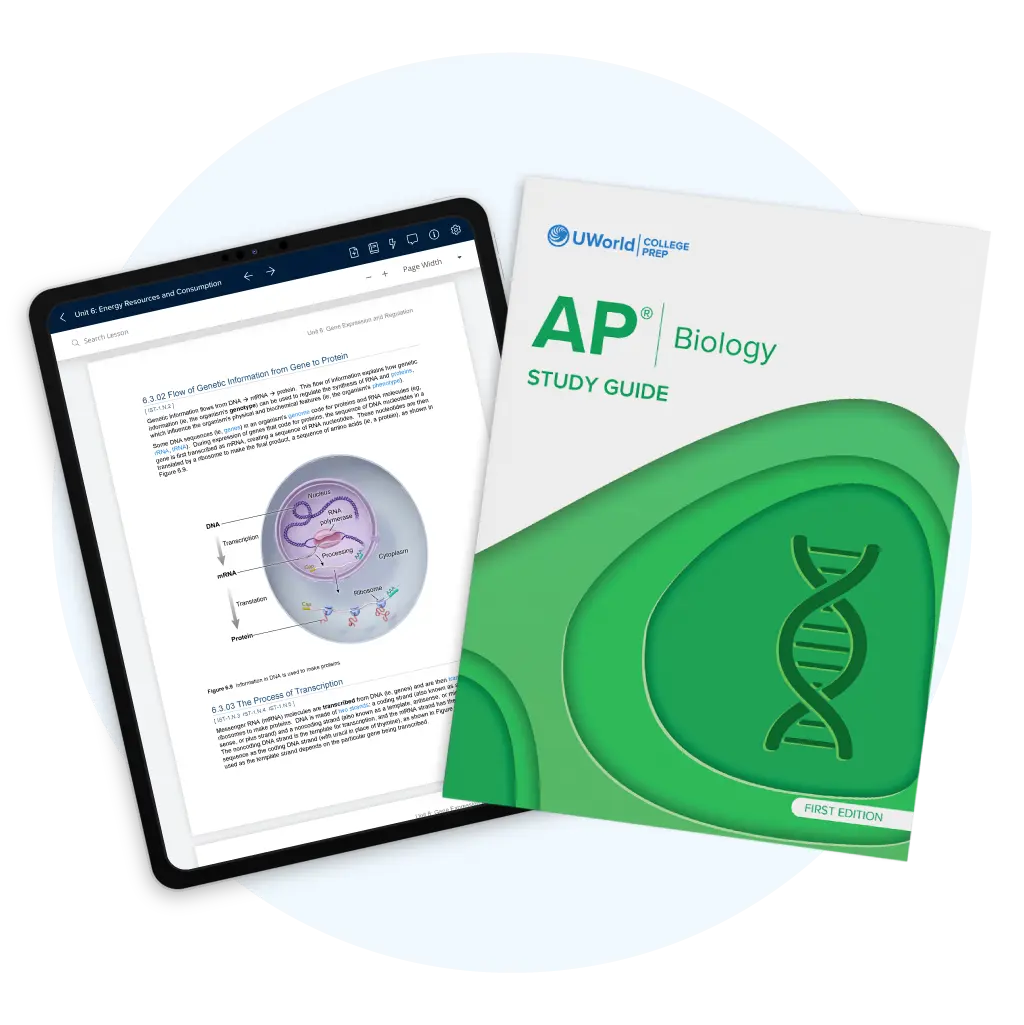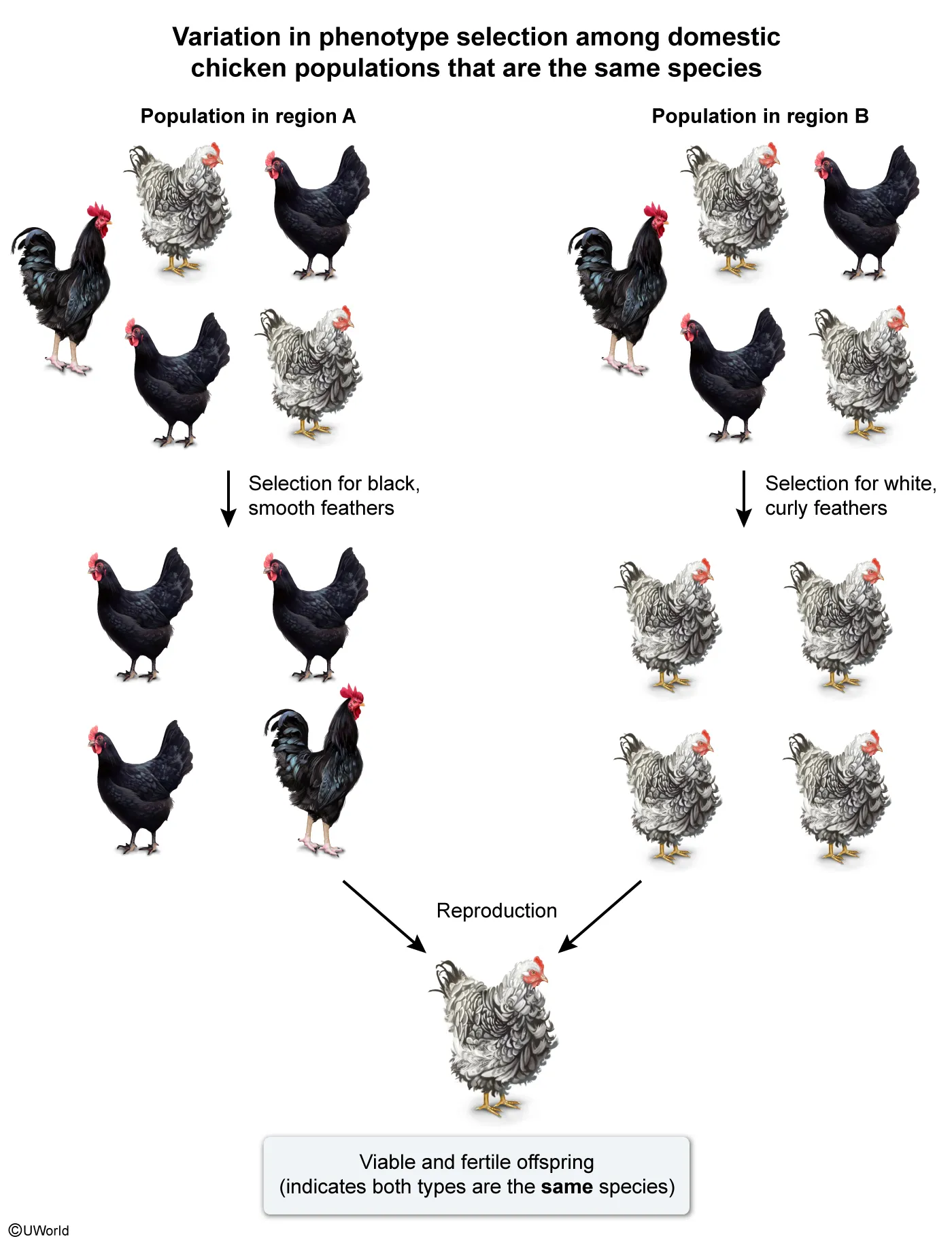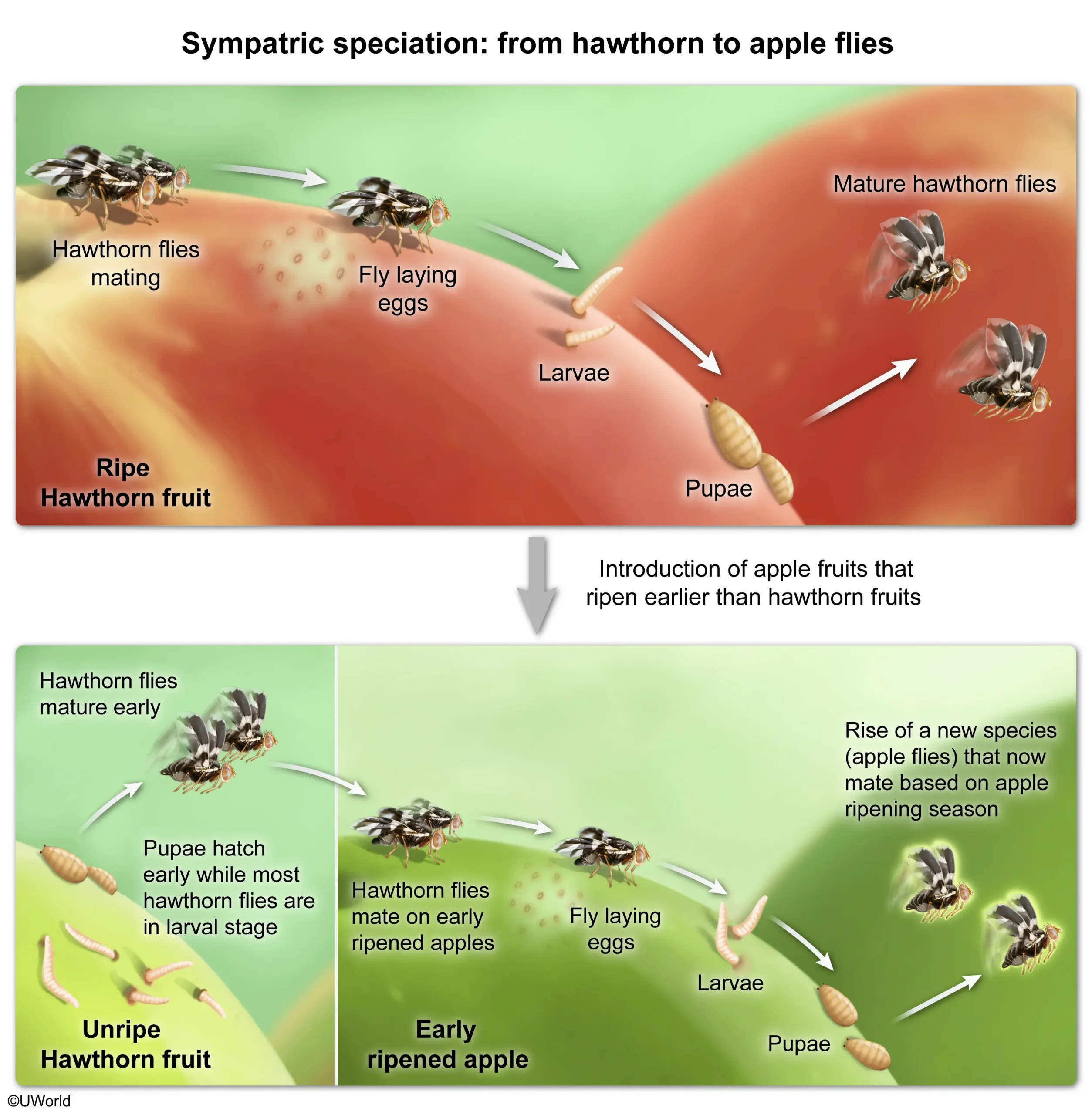AP Biology Unit 7 Review and Practice Test
Natural Selection is one of the most tested topics on the AP Biology Exam. It covers Darwin’s theory of natural selection, phylogeny, population change, and selection pressure through MCQs and FRQ sections. Instead of labouring through the textbook, UWorld’s AP Bio Unit 7 review, developed by industry experts, provides a path to score a 5 in the exam with videos that stick, interactive study guides, and realistic practice questions, all in one go.
Turn AP Biology Unit 7 into a Scoring Advantage, Not a Limiting One.
The Natural Selection unit often determines the top scorer, so don’t let it drag you down. Most students struggle because the questions test application, data interpretation, population change, among other topics, not simply recall. That’s where UWorld’s AP Bio Unit 7 review has resources built to make you earn points on the actual exam, rather than losing them to uncertainty.
Engage and Evolve Your Understanding with Visual Walkthroughs
Be it adaptation, allele frequency shifts, or speciation, the videos will help you move past memorization and into real comprehension. Each video breaks down concepts and is developed around how Unit 7 AP Bio MCQs and FRQs are written, so you’re learning in the same format you’ll be tested on.
Interactive Study Guides
With UWorld’s interactive AP Bio Unit 7 study guides, you get targeted explanations of selection pressure, genetic variation, and population shifts. Coupled with visuals and illustrative diagrams, the guide trains your brain to recognize patterns and sort through the extra noise of dense text into simple, digestible forms.
Try These AP Biology Unit 7 Practice Test Questions
Question
Many unique types of domestic chickens have been identified throughout the world. Although these unique chicken types often exhibit many phenotypic differences, they can still interbreed with one another and produce viable and fertile offspring when introduced. These findings indicate that
| A. separation of different domestic chicken types in different locations caused them to evolve into distinct species with unique phenotypes. | |
| B. selection for different phenotypic traits has varied among chicken populations, leading to the evolution of different domestic chicken types that have remained members of the same species. | |
| C. many phenotypic variations in domestic chickens have led to changes in gamete production, preventing the exchange of genetic information among different domestic chicken types. | |
| D. multiple unique ancestral species gave rise to different domestic chicken types that could each fill different ecological niches. |
Explanation
A species is a group of organisms in which members can interbreed with one another to produce viable, fertile offspring. In contrast, reproductively isolated organisms (ie, those that cannot interbreed to produce viable, fertile offspring) are generally considered to be different biological species.
In this question, many unique types of domestic chickens are found throughout the world. Although these chickens often exhibit many phenotypic differences, they can still interbreed to produce viable, fertile offspring when introduced. Therefore, the selection of different phenotypic traits has likely varied among these chicken populations, leading to the evolution of different domestic chicken types expressing unique phenotypes. However, because these different types can still successfully interbreed, they have remained members of the same species.
(Choice A) Because these different domestic chicken types are able to produce viable, fertile offspring, they are still the same species. Therefore, separation of different domestic chicken types in different locations likely did not cause them to evolve into distinct species (ie, through allopatric speciation).
(Choice C) Because different chicken types can still successfully interbreed, they can still exchange genetic information with one another. This indicates that they likely exhibit similar forms of reproductive processes, including gamete production via meiosis.
(Choice D) Different domestic chicken types interbreed and are therefore the same species. Therefore, they likely originated from a single domestic chicken ancestor, not multiple unique ancestral species that gave rise to chicken types able to fill different ecological niches.
Things to remember:
A biological species is defined as a group of organisms in which members can interbreed and produce viable, fertile offspring.
Question
A group of biologists observing maggot flies in the same geographic area of North America noticed variation in the fruit on which the flies lay their eggs. One group of flies—which the biologists termed "apple flies"—prefer to mate and lay their eggs on apple fruits. The other group of flies—termed "hawthorn flies"—prefer to mate and lay their eggs on hawthorn fruits. Although hawthorn fruits are native to this area of North America, the apple fruits were not introduced until the mid-1800s. The biologists attribute these behavioral differences in flies to a scent preference for each fruit type with a genetic basis. In addition, they found that apple fruits ripen earlier than hawthorn fruits and that apple flies mature and begin to mate earlier than hawthorn flies. Through various scientific experiments, they were able to confirm that apple flies and hawthorn flies are different species, one of which arose through sympatric speciation.
Based on the information given, which of the following is a plausible explanation for how sympatric speciation occurred in maggot flies?
| A. The apple flies and hawthorn flies are hybrids of several ancestral fly species that no longer exist. | |
| B. A geographic barrier separated the habitat of hawthorn flies into areas containing either only apple trees or only hawthorn trees, causing apple flies to evolve from hawthorn fly populations in areas containing only apple trees. | |
| C. All maggot flies originally mated and laid their eggs on hawthorn fruits but, as time passed, flies that matured earlier began to mate and lay their eggs on apple fruits and evolved into a different species that made use of only apple fruits for reproduction. | |
| D. Both species evolved at the same time from a common ancestor and, over time, exploited different food resources to better survive. |
Explanation
Sympatric speciation occurs when a new species evolves from a living ancestral species. Consequently, the ancestral species and the new species are reproductively isolated but still live in the same geographic area.
This question discusses maggot flies (ie, apple/hawthorn flies). These fly populations are different species, one of which arose through sympatric speciation—meaning that one must be the ancestral species and the other must be the new species.
Only hawthorn fruits were originally found in this area; therefore, all maggot flies were originally hawthorn flies as they laid eggs on hawthorn fruits. However, once earlier-ripening apples were introduced, some hawthorn flies that matured earlier were also able to mate earlier and lay eggs on the already ripe apples instead of still-unripe hawthorn fruits. Over time, apple flies likely evolved into a new species by acquiring genetic differences (eg, altered scent preference) and becoming reproductively isolated from hawthorn flies.
The other answer choices do not explain sympatric speciation in maggot flies.
(Choice A) No evidence is given that two different species were present (nor could create hybrids) prior to the appearance of apple flies and hawthorn flies.
(Choice B) Although a geographic barrier could have caused allopatric speciation, no evidence is given that a geographic barrier ever separated apple flies and hawthorn flies.
(Choice D) Divergent evolution occurs when two or more groups descended from the same common ancestor evolve different characteristics due to different environmental pressures and become new species. However, in this case, hawthorn flies are the common ancestor.
Things to remember:
Sympatric speciation occurs when a new species evolves from a living ancestral species, with both species currently living in the same geographic area.
Question
Which of the following statements best represents artificial selection?
| A. Human activity can result in increased global temperatures, which causes certain arctic caribou populations to produce offspring earlier in the year than ancestral populations. | |
| B. Heterozygous humans carrying one copy of a recessive allele that would normally cause a specific lung disease when present in two copies may be protected from developing other forms of lung disease. | |
| C. A rodent species was displaced from their habitat and separated into two different populations when a city was built in a rural area, after which each rodent population developed unique molar teeth for grinding the different foods available in each new environment. | |
| D. A farmer breeds only strawberry plants bearing fruits with the highest sugar content so that future strawberry plant generations exhibit a high sugar content phenotype. |
Explanation
During artificial selection, humans purposefully select organisms with desirable traits for breeding to increase the frequency of these traits in future generations. In this way, humans can alter the genetic and phenotypic makeup of certain populations over time.
Accordingly, the best example of artificial selection in this question is that a farmer breeds only strawberry plants bearing fruits with the highest sugar content, which would allow strawberries produced by future generations of plants to continue to have a high sugar content (to be sweet).
(Choices A and C) Human activities (eg, activities leading to climate change, building a city) may disrupt wild populations. However, earlier offspring production in caribou due to climate change or the development of unique molar teeth in two rodent populations separated by a city were likely the result of these organisms undergoing natural (not artificial) selection in response to facing new selective pressures.
(Choice B) If having only a single copy of a recessive allele along with a dominant wild-type allele (ie, a heterozygote) protects against disease, this is called heterozygote advantage. However, disease protection in heterozygotes carrying one copy of an allele that would normally cause lung disease if it was present in two copies is not an example of artificial selection.
Things to remember:
Artificial selection occurs when humans selectively breed organisms exhibiting desirable traits, causing the frequency of these traits to increase in future generations.

Take Your Natural Selection Review On the Move
Whether you’re travelling back home or have a short break, quick sessions on adaptation, allele shifts, or population change add up fast when the format mirrors the real test. Whether on grid or off grid, keep every resource close to you with the UWorld App.
Stand Out
with a Top Score in AP Biology
Finish your Unit 7 AP Biology review and continue mastering all units with UWorld. Boost your performance and set yourself apart as a strong candidate for competitive colleges, majors, and scholarships by earning a top score.
Get our all-in-one course today!
- Focused AP Bio Videos
- Print & Digital Study Guide
- 500+ Exam-style Practice Questions
- Customizable Quiz Generator
- Adjustable Study Planner
- Realistic Timed Test Simulation
- Colorful Visual Explanations
- Progress Dashboard
- Smart Flashcards & Digital Notebook
Hear From Our AP Students

UWorld’s service is pretty good and helps provide a lot of explanations on subjects I haven’t been confident on before.

The questions here are the most realistic to the AP tests I've seen so far! I appreciate the ability to customize tests as well.

The best part is that all options are well-explained, telling clearly why they are the right option.
Frequently Asked Questions (FAQs)
What is AP Biology Unit 7, and why is it important for the exam?
AP Biology Unit 7 focuses on natural selection, the principle that drives evolution and explains how populations adapt over generations. It is one of the most heavily weighted units on the AP Biology exam, connecting earlier genetics concepts with evolutionary reasoning. Understanding how traits change within populations helps explain many major biological patterns, such as antibiotic resistance and species diversity, which is why mastering Unit 7 is crucial for both multiple-choice and free-response questions.
Unit 7 represents the transition point between molecular biology and large-scale evolution. It trains you to think like a biologist by analyzing data, interpreting trends, and applying cause-and-effect reasoning, rather than memorizing facts. The unit’s questions often integrate content from previous units, testing your ability to link gene expression, inheritance, and environmental change. Excelling in this section shows examiners that you can apply biological logic, not just recall definitions, which is key to scoring a 5.
UWorld’s AP Biology Unit 7 review helps reinforce this reasoning-based approach. The platform explains natural selection through data-driven visuals and realistic exam-style problems, mirroring College Board expectations. When paired with official materials, it strengthens your conceptual understanding and confidence for the test.
What are the main topics covered in AP Biology Unit 7: Natural Selection?
AP Biology Unit 7: Natural Selection explains how evolution occurs through variation, adaptation, and changes in population. The core topics include Darwin’s principles, population genetics, allele frequency, evidence of evolution, phylogeny, and speciation. Together, these describe how organisms adapt to environments and how new species arise. The AP Biology exam repeatedly draws from these foundations; mastering them is essential for high performance.
Here are the topics included:
- Natural and artificial selection
- Population genetics
- Evidence of evolution and common ancestry
- Phylogeny
- Speciation and variations in populations
- Origin of life on Earth
UWorld’s AP Biology natural selection lessons combine interactive diagrams, guided examples, and exam-style explanations. They help students visualize relationships among selection types, variation, and population change, and transform memorization into functional understanding.
How does AP Biology Unit 7 connect natural selection with other units?
Unit 7 in AP Biology bridges molecular biology and ecology by illustrating how microscopic genetic variation gives rise to large-scale evolutionary patterns. It connects Heredity (Unit 5) and Gene Expression (Unit 6) to environmental adaptation and population change. These links explain how the same DNA-level processes influence entire ecosystems.
Recognizing these connections is important because AP questions rarely isolate a single concept; instead, they often require an understanding of multiple concepts. A prompt might ask how gene mutations affect survival rates or how population dynamics reflect molecular changes. Understanding Unit 7 in the context of other units enables you to transition smoothly from one concept to another, thereby strengthening your reasoning in integrated FRQs and multiple-choice questions.
UWorld’s AP Biology Unit 7 review emphasizes these cross-links through multi-step problems combining genetics, selection, and ecology. This layered approach develops the analytical flexibility necessary to interpret interdisciplinary exam questions accurately.
What’s the best way to study for AP Bio Unit 7 and plan your review sessions?
Studying AP Biology Unit 7 effectively requires a logical sequencing approach. The unit’s complexity stems from the way its topics, like natural selection, population genetics, and phylogeny, build upon one another. Without a plan, it’s easy to mix definitions and lose sight of the larger evolutionary story. A structured review ensures clarity and lasting retention.
UWorld’s AP Biology Unit 7 follows this same logic, offering lessons and practice questions in the exact order outlined by the College Board. This organization allows you to progress systematically without missing core concepts.
You can begin with Darwin’s theory and types of selection, then move to allele frequencies and Hardy-Weinberg principles, ending with speciation and evidence of evolution. Each stage connects conceptually to the next, allowing you to see cause and effect across topics. Consistent sequencing transforms a fragmented study into a coherent understanding, which directly impacts scoring accuracy.
How can I organize my AP Bio Unit 7 review to cover all key concepts efficiently?
AP Biology Unit 7 contains multiple overlapping concepts that form the foundation of evolution. Organizing them logically prevents confusion and helps you see how natural selection, genetic variation, and speciation work together. An efficient organization supports deeper reasoning during exam questions that demand clear cause-and-effect explanations.
Grouping the content by type improves comprehension. Begin with the mechanisms—mutation, selection, and genetic drift—then proceed to population outcomes, such as allele frequency change and speciation. Finish by reviewing evidence-based concepts such as phylogeny and common ancestry. Structuring your notes this way builds a mental framework that mirrors the flow of the AP Biology Unit 7 test and saves time during revision. This structure helps you connect ideas easily while reinforcing each stage of evolution through practice and feedback.
What types of FRQ questions are usually asked in the AP Biology Unit 7 exam?
The AP Biology Unit 7 FRQs typically assess how well you can analyze data related to evolutionary change. They may present population graphs, allele frequency tables, or comparative traits across species. These questions test whether you can explain mechanisms of evolution rather than just identify them.
Understanding the logic behind these FRQs is essential. They often ask you to describe how environmental pressures alter population traits or how phylogenetic trees support claims of common ancestry. Writing precise cause-and-effect statements backed by data earns the most points. These prompts reveal your ability to reason through natural selection instead of reciting facts.
UWorld’s FRQ practice questions for AP Biology Unit 7 follow this same model, showing how to structure answers clearly and justify reasoning with evidence. Each explanation aligns with the College Board scoring rubric, making it easier to self-assess progress.
How can I improve my performance on AP Bio Unit 7 multiple-choice and free-response questions?
Improving performance in AP Biology Unit 7 requires more than memorizing terms and depends on understanding the logic of evolution and applying it under exam conditions. Both multiple-choice and free-response questions evaluate how clearly you can explain population changes and selection pressures rather than simply naming processes. The AP Biology exam expects you to reason through data sets, graphs, and case studies that connect natural selection, variation, and adaptation.
UWorld’s AP Biology Unit 7 practice test content mirrors this challenge level. Each question includes detailed reasoning for correct and incorrect options, helping you spot thought errors early. Repeated practice using these explanations strengthens both conceptual clarity and test strategy, leading to measurable score improvement.
Analyzing patterns in previous tests, identifying relationships between variables, and demanding structured arguments requires practice. Hence, review every incorrect answer to understand whether the error was conceptual or interpretive. Over time, you’ll develop pattern recognition, a skill that directly impacts exam performance.
What’s the best way to remember key ideas like adaptation, variation, and speciation in Unit 7?
Adaptation, variation, and speciation are the backbone of AP Biology Unit 7: Natural Selection. Together, they explain how evolution shapes life. Adaptation determines which traits enhance survival, variation ensures diversity for selection to act upon, and speciation marks the branching of new species from ancestral ones. Remembering how these concepts connect rather than treating them as separate definitions makes Unit 7 easier to understand and recall under exam pressure.
To build strong recall, focus on how each process leads to the next:
- Variation introduces genetic differences within populations.
- Natural selection favors traits that are advantageous, leading to adaptation.
- Over time, accumulated changes lead to speciation and the formation of new lineages.
Organizing your notes this way makes cause and effect clear. You can also pair real examples with each process, like antibiotic resistance for adaptation or Darwin’s finches for speciation. Visual reinforcement through charts or flow diagrams strengthens understanding.
UWorld’s AP Bio Unit 7 study guide illustrates these ideas with step-by-step visuals and case-based examples. Its explanations emphasize connections rather than repetition, helping students link adaptation, variation, and speciation as one continuous process of evolutionary change.
How should I approach population genetics and phylogeny questions in AP Biology Unit 7?
Population genetics and phylogeny sit at the analytical core of AP Biology Unit 7. They test whether you can use data to explain evolutionary patterns and identify relationships among species. The College Board includes these topics because they represent how modern biology quantifies and visualizes the concept of evolution.
To approach population genetics effectively, practice calculating allele frequencies and understanding the conditions of the Hardy-Weinberg equilibrium. For phylogeny, study how to read branching patterns, nodes, and derived traits to determine shared ancestry. Use evidence to explain why one evolutionary pathway makes sense over another. Try to narrate your thought process as you analyze a data table or tree: “This species shares more derived traits; therefore, it’s more closely related.” Doing this out loud or in writing reinforces logical structure.
UWorld’s AP Biology Unit 7 test materials contain population and phylogenetic questions modeled after real exam formats. Detailed explanations demonstrate how to accurately interpret both mathematical and visual data, equipping you to respond with precision and confidence on exam day.
What strategies help students write stronger FRQ answers for AP Bio Unit 7: Natural Selection?
Free-response questions for AP Biology Unit 7 measure how well you can explain relationships between genetic variation, selection, and environmental change. They require precision, not memorization, and reward clear, evidence-based reasoning.
Use this checklist for effective FRQ writing:
- Begin with a concise claim that directly answers the question.
- Support it with data or a relevant example from natural selection or population genetics.
- Conclude each paragraph with reasoning that connects the evidence to the claim.
- Use accurate terminology to demonstrate mastery.
These habits ensure your responses are both structured and scientifically valid. Reviewing sample FRQs helps you identify how strong essays balance brevity and logic. Time management also matters; spending too much time on introductions reduces the space for evidence. Practicing under timed conditions refines both clarity and pace.
UWorld’s AP Biology Unit 7 FRQ practice trains these exact skills. Annotated examples and scoring rubrics guide you through structure and vocabulary, showing what earns points and what weakens explanation quality.
When should I start taking AP Biology Unit 7 practice tests for the best results?
Timing plays a significant role in how well you retain and apply AP Biology Unit 7 concepts. Practice tests aren’t just review tools but diagnostic instruments that show whether your reasoning matches College Board expectations. Starting at the right point ensures your practice builds accuracy rather than reinforcing errors.
UWorld’s AP Biology Unit 7 practice test modules follow this progression naturally. You can start with topic-based quizzes, then move to full-length tests. The performance analytics pinpoint exactly where improvement is needed, ensuring every session contributes to higher readiness.
Early testing reveals content gaps and highlights weak reasoning patterns, while mid-to-late-stage tests focus on building timing and stamina. Treat every test as a feedback loop and review wrong answers immediately, categorize mistakes, and revisit those topics. In the final weeks, shift focus from content recall to pacing and endurance. By combining conceptual review with timed simulations, you develop both understanding and resilience.
How can I structure AP Bio Unit 7 practice sessions to build exam speed and accuracy?
Improving speed and accuracy in AP Biology Unit 7 depends on structured repetition, not random practice. Since the unit’s questions often blend data and reasoning, your sessions should train both understanding and pacing.
Use a three-phase structure to maximize results:
- Begin with untimed practice to build conceptual clarity and eliminate guesswork.
- Move to short, timed sets of 10–15 questions to practice focus and consistency.
- End with full-length Unit 7 sections under exam conditions to build endurance.
After each session, analyze not only which questions you missed but why – was it a content gap, misread graph, or time mismanagement? Write one-sentence reflections summarizing each error; this active correction improves retention. Tracking timing data also helps you identify whether you spend too long on multi-step reasoning questions.
UWorld’s adaptive AP Bio Unit 7 review platform mirrors this method. Its question analytics and pacing feedback help you fine-tune both content mastery and timing efficiency, turning structured practice into measurable performance growth.
What are the most common mistakes students make in AP Biology Unit 7?
Students often lose points in AP Biology Unit 7 by misapplying key principles or overlooking connections between data and theory. These mistakes are typically conceptual, rather than factual, and can be corrected through awareness and deliberate reasoning.
Common issues include confusing random events, such as genetic drift, with selective processes, misinterpreting phylogenetic trees, and treating adaptation as an immediate response rather than a gradual, generational shift. Others fail to link environmental context with allele frequency changes, weakening cause-and-effect reasoning. These errors occur when students rely on memorized patterns instead of analysis.
The most effective way to avoid them is to slow down and explain each concept in your own words—“Why does this process occur?” rather than “What is it called?” Reflection after every practice test strengthens accuracy by making you aware of your thought process.
UWorld’s AP Biology Unit 7 review includes notes that flag these exact errors within question explanations. Seeing both the correct and incorrect logic side by side helps train a deeper conceptual understanding and long-term precision.
Where can I find reliable AP Bio Unit 7 notes, flashcards, or cheat sheets for quick revision?
Quick-reference tools are invaluable when revising AP Biology Unit 7: Natural Selection. They condense dense concepts like adaptation, allele frequency, and speciation into bite-sized summaries, perfect for reinforcing understanding before exams.
When selecting or creating these tools, focus on depth, not volume:
- Use notes to summarize key ideas such as selection types, genetic drift, and mutation.
- Flashcards should target definitions, examples, and formulas, such as the Hardy-Weinberg equilibrium.
- Cheat sheets are best for connecting related concepts, such as variation, adaptation, and speciation, through diagrams or short sequences.
These resources are helpful because they promote active recall rather than passive rereading. Reviewing them in short, frequent bursts strengthens retention more than one long study session. Rotating between visual and textual materials keeps memory active across learning styles.
UWorld’s AP Biology study guide and flashcards simplify this process. Their visuals and structured summaries align with College Board standards, making them reliable companions for short but effective daily reviews.
Are downloadable AP Biology Unit 7 study guides and practice PDFs available online?
Many students benefit from using offline materials for AP Biology Unit 7 preparation. Downloadable study guides and practice PDFs give flexibility, allowing focused review without constant screen time. These materials usually summarize key theories, diagrams, and data-based exercises relevant to the AP Biology exam.
The advantage of these resources lies in their adaptability. You can print, annotate, and highlight important terms, or solve problems repeatedly until the logic becomes second nature. Some guides include short-answer and FRQ-style questions modeled after the College Board format, offering valuable written practice. To maximize the benefits, combine offline review with timed online practice—use PDFs to reinforce understanding and digital tools to test speed and accuracy. This dual approach ensures comprehensive readiness for all question formats.
UWorld’s AP Biology Unit 7 study guide and QBank integrate seamlessly with printed resources. Together, they cover both content reinforcement and practical testing experience, allowing students to study effectively across online and offline environments.
